50th Aniversary, L'Anse aux Meadows, NHSC
L'Anse aux Meadows National Historic Site, NF, August 2010
2010 marked the 50th aniversary of the discovery of the norse buildings at L'Anse aux Meadows.
To celebrate that aniversary Parks Canada put on a number of activities. Their August activity was to bring
in DARC to extend the existing interpretative program. In order to better suit the environment and existing staff DARC used a modified scenario for this presentation.
The Althing in Iceland of 1000 was an important one. As always, many disputes were heard and settled, to the gain of some and loss of others. One of the significant decisions made at the Althing was to encourage all Icelanders to accept Christianity. This did not sit well with all. As always, many things were discussed and deals made away from the Speaker's Rock. Some came just to be seen, traders and artisans came to display their wares, seeking customers and commissions at the gathering.
The days of the Landnam were long gone, so good (even acceptable) farm land had pretty much all been settled. Knowing this, minor chieftains were becoming less and less likely to even oath to new bondi, and not very generous if they would. The famine years were now just a distant memory to only the oldest Icelanders, but still the land was not as bountiful as it once was. One exciting piece of news at the Althing was that of Eric the Red's new Green Land, and even mention of his son Lief's Vinland, both to the west.
There was a man named Ragnarr Thorbergsson, once from Kaupang in Norway. He had come to Iceland, hoping to improve his status and increase his trading. Now Ragnarr was well known for this weather luck, but not so envied for his luck in travel. His voyages never were outright disasters, but certainly things just never turned out as he boasted they would.
Ragnarr's schemes at the Althing did not worked as he had planned. He was certainly not alone in this. There were recent immigrants to Iceland, and even young families and second sons, all of whom found that there was no chance of good farm land in their future. There were some who felt the conversion to the new religion was just not to their taste. As always, there were those who felt a fresh start in a new land would solve what ever problems that always seemed to plague them.
So Ragnarr, nothing if not shrewd, quickly hired a ship to sail to Greenland. He gathered up a load of the hopeful and disgruntled who would pay him passage against the chance to settle on new farms of their own. As it happened, things didn't go perfectly on the voyage, with the ship blown off course. Like Bjarni before them, they found themselves near Vinland. Knowing the tales freshly told, they found their way to Leif's buðir and found some Greenlanders already there. Most were not pleased to find that they would need to lay over the winter before continuing to Greenland in the spring.
This mixed group of farmers and craftsmen, of varied ages and original homelands, now finds themselves stuck together in close quarters in Vinland. They are settling in to the outpost best they can, and trying to help get ready for the winter soon to come. The ship and most of the crew has gone off down the coast to harvest valuable timber, hoping to improve their lot when they finally make it to Greenland.
The presentation included hundreds of detailed replicas of period objects:
domestic goods, cooking equipment, simple textile tools, woodworking tools,
basic blacksmithing equipment, weapons, storage, and more. 14 members of DARC spent 10 days demonstrating
a number of activities at seven stations in conjunction with the parks staff. The highlight of the trip was the successful final
smelt in our experimental sequence to recreate the smelt performed a thousand years ago on site.
On the ferry ride to Newfoundland
 |
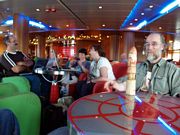 |
| |
| Waiting for the boat |
Passing time on the boat |
In the quiet before the staff and visitors arrive it is a pretty place.
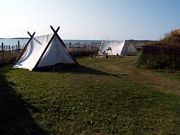 |
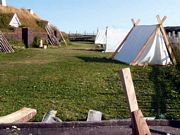 |
 |
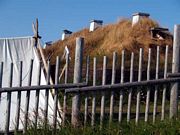 |
| The entrance |
behind the buildings |
Overview |
Main Hall |
On most days the first station a visitor would see was the domestic activities. When weather allowed
this was set up around an open air fire just inside the gate, otherwise it moved into the small dwelling house.
Around this fire Bera and her thrall Kadja made our daily lunches: soups, breads, cheeses. Dishes and laundry
were washed as well.
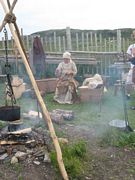 |
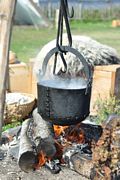 |
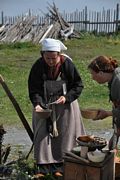 |
 |
| Mending Clothes |
Soup for lunch |
Planning lunch |
Washing dishes |
Moving around to the left the tourist would have come across Ragnarr's trading tent. Here a visitor would be
regaled with tales of far away places and the exotic materials collected for sale to discerning customers. Iron;
worked iron in the form of hinges, arrrow heads; beads, necklaces; fabrics; and more. A visitor could also
engage in a game of hnefatafl, or discuss navigation techniques.
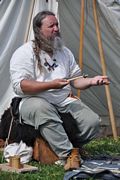 |
 |
| |
| Trade goods |
Rock Crystal |
Continuing on to the woodworking station Thorgeir, Grimbold, and Rig could be seen turning bowls on the spring
pole lathe; or working on a piece for the faering being repaired onsite. Some lucky visitors would hear tales of the
home country from Rig.
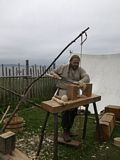 |
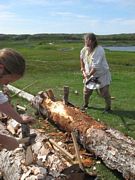 |
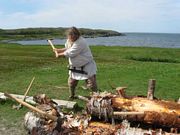 |
 |
| Grimbold turning a bowl |
Spliting lumber |
Spliting lumber |
Axes |
 |
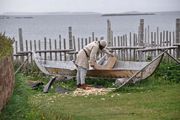 |
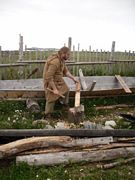 |
|
| Making a rib for the faering |
Fitting the replacement rib |
Adjusting the replacement rib |
On fair weather days Þorgrimmr could be seen sitting in the shade of the house carving bone, or antler. Wednesday's weather required working indoors for much of the day.
One interesting result was the discovery that it is pretty much impossible to carve bone indoors in a Viking house. Þorgrimmr was working in the fire hall of the reconstructed
house in L'Anse aux Meadows, with the fire lit, the smoke holes open, and the doors open. Even with all of those light sources, he had to stand in the doorway to work the ring
and dot tool, never mind actually carve with the knife. The bone carving is too fine to find by touch, and was invisible under those lighting conditions. Wood carving is probably
possible in that light, and bone work may be possible if done near a lamp. No doubt the weather will encourage future experiments in low-light carving.
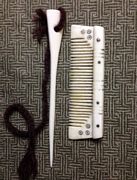 |
| | |
| Carving Examples |
From here a visitor would proceed into the main hall to meet with staff from Parks Canada who would tell them
stories of Leif's arrival and the building of the hall.
The next stop for many visitors was Kaðlín's loom and a discussion of the types of weaving, the effort
required to prepare fleece and spin it to prepare to weave.
Proceeding further in a visitor would need Auðr and Jorunn for a discussion of net making, spinning, and
naalbinding and a chance to try each of those skills. Tablet weaving was a specialty of Hrobjartr.
 |
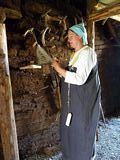 |
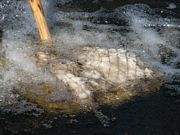 |
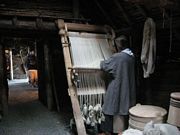 |
| Jorun discussing Weaving |
Auðr working on a net |
Washing fleece |
Warpping the loom |
 |
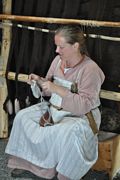 |
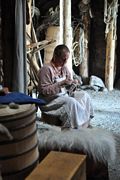 |
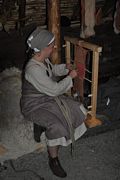 |
| Katla wire-weaving |
Kaðlín naalbinding |
Taking a break from weaving |
Jorunn working on sprang |
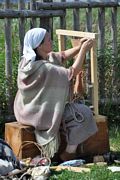 |
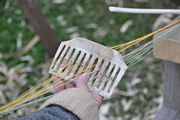 |
| |
| Sprang leggings. |
Weaving trim |
Outside in the back a visitor would find Ketill and Grettir working the forge, or preparing charcoal. It was
also here on the Saturday that the smelt was held.
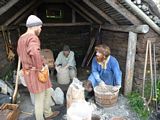 |
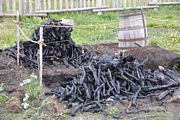 |
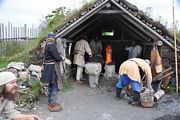 |
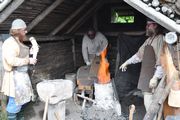 |
| Building the iron smelter |
Perparing charcoal |
Smelt in progress |
Smelt in progress |
 |
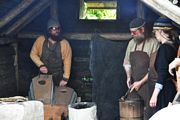 |
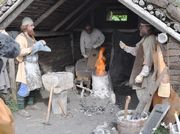 |
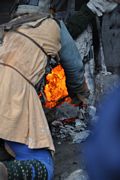 |
| Smelt in progress |
Smelt in progress |
Smelt in progress |
Extracting the bloom |
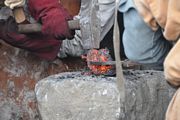 |
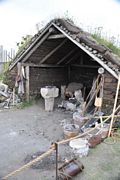 |
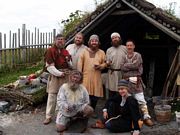 |
 |
| Compacting the bloom |
Smelter at day's end |
Team at day's end |
Working with iron |
Some additional unplanned activities occurred.
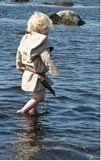 |
 |
| |
| Emundr cools his feet |
Basket weaving |
In addition to the interpretative activities, members of DARC provided lectures for the public at the
interpretative centre. These lectures included:
- Norse Music
- Did the Vikings sing when they rowed? Could Thorsteinn carry a tune? This lecture will introduce the instruments played by the Norse and demonstrate some of what remains of their musical traditions.
- Bead Production in Scandinavia: converting archaeological evidence to a practical method
- The 10th century writer Ibn Fadlan assures us that Vikings loved their beads, and archaeological evidence suggests to us that beads were produced in a number of locations in Scandinavia. Unfortunately the Viking Era Scandinavians neglected to document their production methods on YouTube for us. Over the past two years members of DARC have performed a number of basic attempts at bead production. This session will explore the archaeological and anthropological background to bead production; the original questions that were to be explored in the preliminary experiments; tentative conclusions from those experiments; and next steps in the experimental program.
- Vikings Unearthed
- This introduction to the Viking age
will explore the archeology and reconstruction of the Oseberg site. Learn about the way the Norse lived and what they valued through this examination of the richest archeological find from the time period.
- Pastimes of the Vikings
- "It's all fun and games when someone loses an eye!" Actually, Norse pastimes tended to be a little less violent than that. This class will cover the basic rules of Tafl, as well as examining other past-times that can be used to fill those long hours of leisure time.
- Iron Smelting at Vinland - Converting archaeological evidence to a practical method
- The excavations at L'Anse aux Meadows Newfoundland uncovered remains interpreted by the original excavation team as a 'Furnace Hut' containing an iron smelting furnace. The remains are fragmentary, and at best only represent the last stages of a complex physical sequence. What might this furnace have looked like, and exactly how might the smelting process have been undertaken by the Norse, 1000 years ago? As well as considering furnace remains from Norway and Iceland, practical experience derived from a long series of experimental iron smelts will be considered.
Experimental activities were also conducted including:
- Pewter casting
- Glass Bead Making
- Iron Smelting
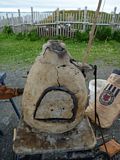 |
 |
| |
| Bead furnace |
Making a bead |
 Dark Ages Re-Creation Company
Dark Ages Re-Creation Company
























